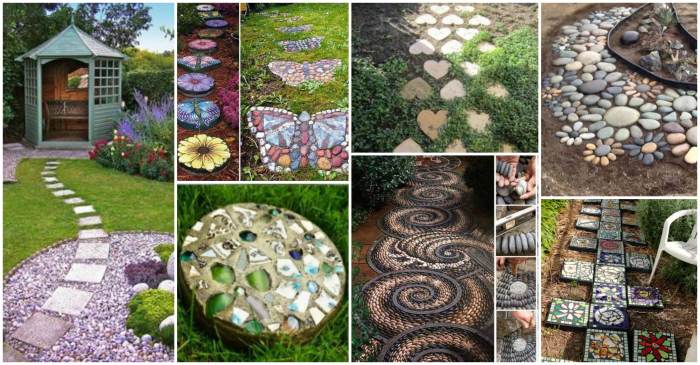Decorative Stepping Stones transform ordinary pathways into captivating garden features. From rustic stone to sleek metal, the variety of materials, designs, and placement options allows for endless creative expression. This guide explores the diverse world of stepping stones, covering everything from choosing the right material and designing your pathway to creating your own DIY masterpieces and sourcing the perfect pieces for your outdoor oasis.
Whether you’re a seasoned gardener or a novice landscaper, this comprehensive resource will equip you with the knowledge and inspiration to elevate your garden’s aesthetic appeal.
We’ll delve into the practical aspects of material selection, durability, and maintenance, offering insights into the pros and cons of various materials like stone, concrete, ceramic, and recycled options. We’ll also explore design considerations, including pathway layout, integration with existing garden features, and the creation of stunning focal points. Finally, we’ll provide a step-by-step guide to crafting your own unique stepping stones, complete with safety tips and decorative techniques.
Design and Placement Considerations: Decorative Stepping Stones

Creating a stepping stone pathway involves more than simply placing stones on the ground; it’s about integrating them seamlessly into your garden’s aesthetic and functionality. Careful consideration of design elements and placement ensures a visually appealing and practical pathway that enhances your outdoor space. The overall style, garden theme, and surrounding landscape all play crucial roles in determining the pathway’s success.
The design process begins with understanding your garden’s existing features and your desired outcome. A pathway should complement, not compete with, the existing elements. This involves choosing materials, shapes, and sizes that harmonize with the overall garden style and color palette. For instance, a formal garden might benefit from uniformly sized, rectangular stones arranged in a straight line, while a more naturalistic garden could use irregularly shaped stones placed in a meandering pattern.
The surrounding landscape also dictates placement – avoid placing stones in areas prone to flooding or excessive shade.
Pathway Design for a Small Garden
Designing a stepping stone pathway for a small garden requires careful planning to maximize space and visual impact. Consider the garden’s dimensions, existing plants, and desired flow of movement when determining the pathway’s layout. Appropriate spacing and gentle curves create a visually pleasing and functional pathway without overwhelming the space. The following example demonstrates a suitable design for a small garden.
- Layout: A gently curving path leading from the garden entrance to a focal point, such as a bench or small water feature. This avoids a rigid, straight line, which can feel unnatural in a small space. The curve should be subtle, allowing for a natural and inviting flow.
- Spacing: Stones should be spaced approximately 12-18 inches apart, allowing comfortable stepping for adults and children. This spacing also allows for planting between stones, adding to the garden’s overall beauty.
- Stone Selection: Use a variety of sizes and shapes of stepping stones, but maintain a cohesive color palette. Mixing natural flagstones with smaller, decorative stones can create visual interest without feeling cluttered.
- Materials: Choose materials that complement the existing garden elements. For example, if the garden uses predominantly natural materials like wood and stone, select stepping stones that align with this theme. Consider using reclaimed materials to maintain a cohesive and sustainable design.
Creative Stepping Stone Arrangements, Decorative Stepping Stones
Stepping stone pathways offer numerous opportunities for creativity. Integrating them with other garden features elevates their aesthetic appeal and overall garden design. The possibilities are extensive, ranging from simple additions to more complex designs.
- Incorporating Water Features: A pathway leading to a small pond or fountain can be enhanced by using stones that reflect the water’s colors or textures. The stones could be placed to create a gentle curve around the water feature, guiding the eye towards it.
- Integrating Plants: Planting low-growing, ground cover plants between the stones adds a touch of color and texture. Consider using plants that complement the stones’ colors and textures. This creates a more natural and visually appealing pathway.
- Creating Focal Points: Larger, more decorative stones can be used to create focal points along the pathway. These stones could be placed at the beginning or end of the path, or at points where the path changes direction.
- Using Different Stone Types: Combining different types of stone, such as flagstone, slate, or river rock, can add visual interest. Ensure the stones complement each other in terms of color and texture to avoid a clashing aesthetic.
Ultimately, the beauty of decorative stepping stones lies in their ability to seamlessly blend functionality with artistic expression. By carefully considering material, design, and placement, you can create a personalized pathway that not only enhances the visual appeal of your garden but also invites exploration and contemplation. Whether you choose to purchase pre-made stones or embark on a DIY adventure, the journey of creating a stepping stone pathway is as rewarding as the final result.
So, unleash your creativity and transform your outdoor space into a haven of beauty and tranquility.